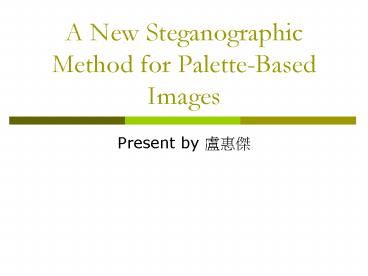A New Steganographic Method for PaletteBased Images - PowerPoint PPT Presentation
1 / 21
Title:
A New Steganographic Method for PaletteBased Images
Description:
Easy to design a secure method under some assumptions about the noise properties ... The first closet color is the same pixel [17,231,31] and the parity is 1 ... – PowerPoint PPT presentation
Number of Views:111
Avg rating:3.0/5.0
Title: A New Steganographic Method for PaletteBased Images
1
A New Steganographic Method for Palette-Based
Images
- Present by ???
2
Outline
- Palette-based images
- Steganography using palette-based images
- Steganographic methods
- EzStego method and problems
- New steganographic method
- Experimental results
- Summary
3
Palette-Based Images
- A palette is a list of the RGB colors used in an
image - Most GIF files on the web today use an 8-bit
palette - This means that of all the 16,777,216 possible
colors, there are only 256 RGB colors in the
image - The bit that is furthest to the right in a binary
number is called the least significant bit (LSB)
4
Steganography Using Palette-Based Images
- Two approaches to message hiding in palette-based
images - Embedding messages into the palette
- Easy to design a secure method under some
assumptions about the noise properties of the
image source (a scanner, a CCD camera, etc.) - The capacity is limited by the palette size
- Embedding into the image data
- Have higher capacity
- Hard to design a secure scheme
5
Steganographic Methods
- Permuting the image palette rather than changing
the colors in the image - Randomized palette will raise suspicion
- Resaving it may erase the information
- Limited capacity
- Hiding encrypted messages in the LSB of the
palette colors (better approach) - One of the most popular message hiding schemes is
EzStego
6
EzStego Method (1/4)
- 1. Sort the palette
- It rearranges the copy of the palette so that
colors that are near to each other in the color
model are near to each other in in the palette
7
EzStego Method (2/4)
- 2. One bit at a time
- Find the index of the pixel's RGB color in the
sorted palette - Get one bit from the input file. Replace the
least significant bit of the index - Find the new RGB color that the index now points
to in the sorted palette - Find the index of the new RGB color in the
original palette - Change the pixel to the index of the new RGB color
8
EzStego Method (3/4)
- Example
- 17,231,31 is color 00100101 in the sorted
palette - The index value of 00100101 is changed to
00100100 - Color 00100100 in the sorted palette is
179,233,36 - 179,233,36 is color 11101110 in the original
palette - The pixel value is changed to 11101110
9
EzStego Method (4/4)
- 3. Recovering the input file
- Find the index of the pixel's RGB color in the
sorted palette - The least significant bit of the index came from
the input file. Write it to the output file. - Example
- 179,233,36 is color 00100100 in the sorted
palette - The least significant bit is 0
- Write 0 to the output file
10
EzStego Problems
- Colors with similar luminance values may be
relatively far from each other - Colors 6,98,233 and 233,6,98 have the same
luminance but represent two completely different
colors
11
New Steganographic Method (1/4)
- 1. The secret message m is first converted into a
binary stream of length M
12
New Steganographic Method (2/4)
- 2. The M pixels for message embedding are chosen
randomly using a pseudo-random number generator
(PRNG) seeded with a secret key
13
New Steganographic Method (3/4)
- 3. The palette is searched for closest colors (in
Euclidean norm) with the same parity as the
message bit - The distance between colors (R1G1B1) and (R2G2B2)
is - The parity of a color is defined as RGB mod 2
14
New Steganographic Method (4/4)
- 4. Extracting the secret message
- M pixels are selected using a PRNG seeded with
user-defined seed - The secret message is simply read by extracting
the parity bits of the colors of selected pixels
15
The Embedding Example
- The first message bit is 0
- 17,231,31 is color 00100101 selected in the
palette - The first closet color is the same pixel
17,231,31 and the parity is 1 (not matched) - The second closet color is the pixel 179,233,36
(the color 00100100 in the palette) and the
parity is 0 (matched) - The pixel color 00100101 change to 00100100
16
The Extracting Example
- The first pixel color selected is 00100100
- The parity bit is 0
- The first message bit is 0
17
Test Images (1/2)
18
Test Images (2/2)
19
RMS Distance
20
The Maximal Change
21
Summary
- The new technique causes approximately 4 times
less distortion to the carrier image than EzStego - The maximal color change is 4-5 times smaller for
the new technique than that of EzStego

